Auditing and Assurance in Australia: GPSA Risk and Control Analysis
VerifiedAdded on 2020/04/07
|13
|2636
|38
Report
AI Summary
This report provides a comprehensive analysis of auditing and assurance practices for GPSA, an organization involved in medical equipment. The report begins with an executive summary and then delves into a detailed analysis of accounting heads, including receivables, current investments, property assets, intangible assets, and capitalization of research and development, assessing associated risks and outlining audit steps for risk minimization. The analysis then proceeds to a ratio analysis for business risk assessment, examining return on equity, total assets, net profit margin, interest earned, account receivable days, current ratio, and debt-to-equity ratio. The report further evaluates the system of internal controls, identifying both effective controls and weaknesses related to trade receivables and sales. It also presents a test of control methods, including observation, re-performance, and inspection. The report concludes with a discussion of internal control weaknesses and recommendations for improvement. This report is a valuable resource for students studying auditing and finance.
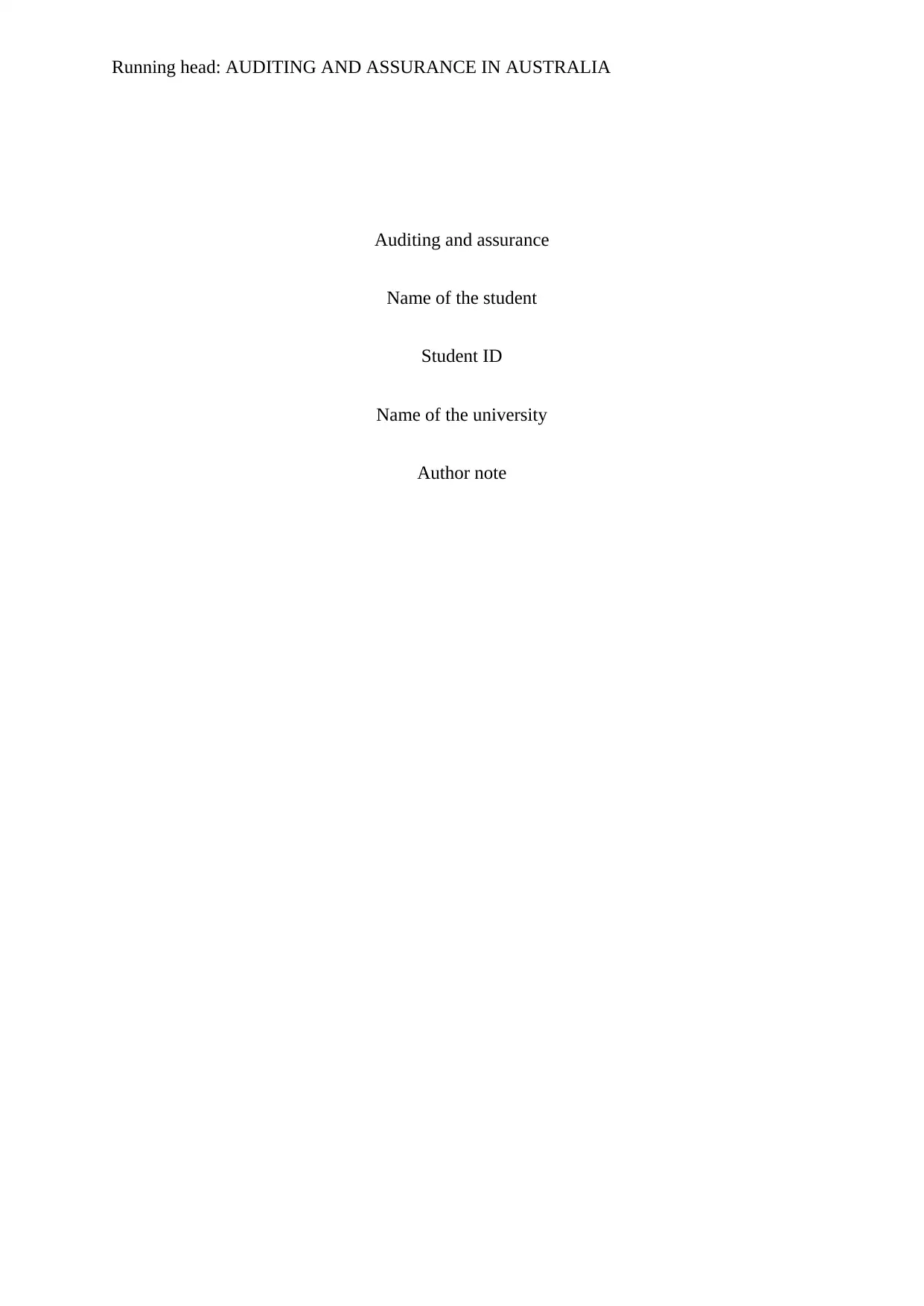
Running head: AUDITING AND ASSURANCE IN AUSTRALIA
Auditing and assurance
Name of the student
Student ID
Name of the university
Author note
Auditing and assurance
Name of the student
Student ID
Name of the university
Author note
Paraphrase This Document
Need a fresh take? Get an instant paraphrase of this document with our AI Paraphraser
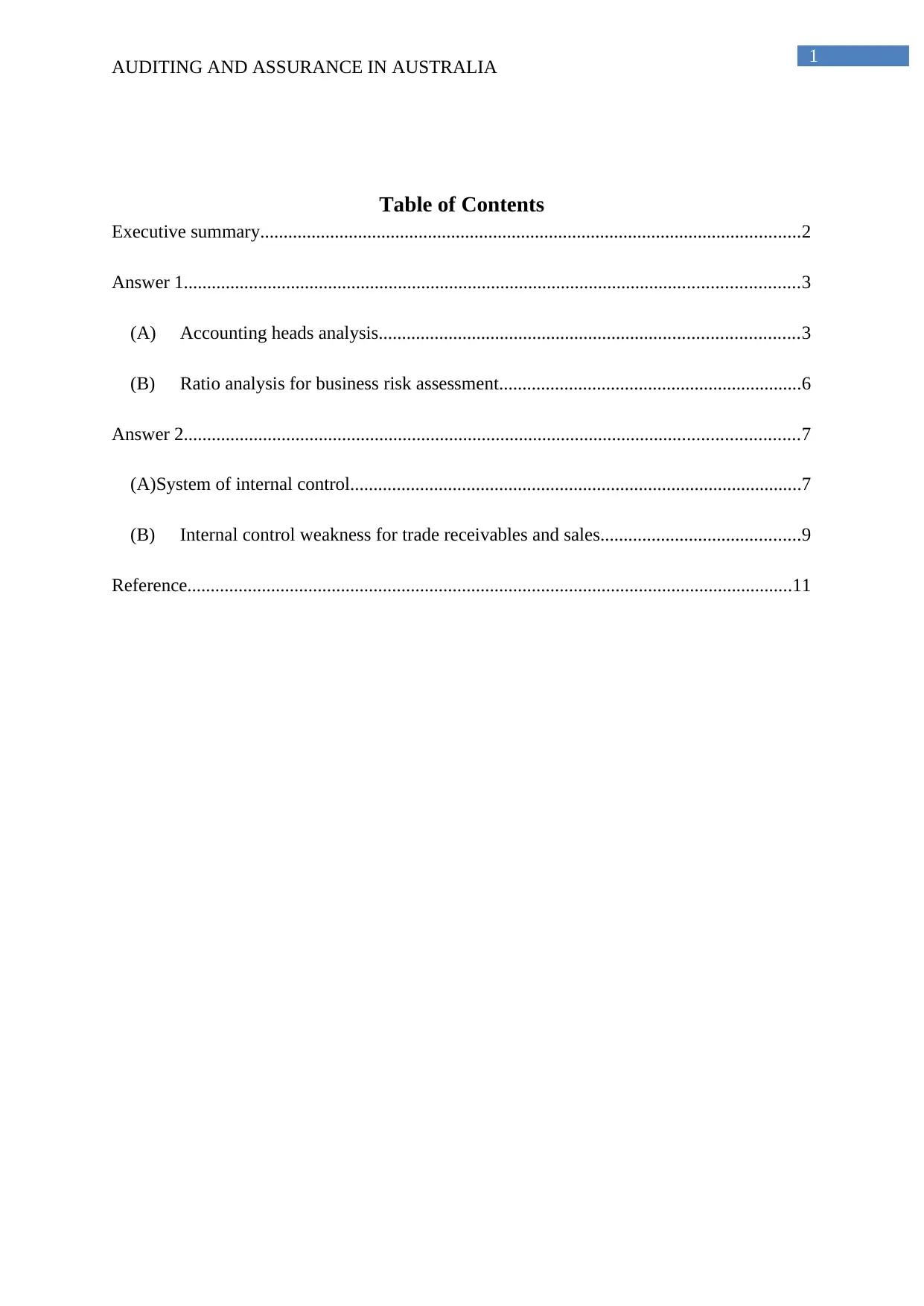
1
AUDITING AND ASSURANCE IN AUSTRALIA
Table of Contents
Executive summary....................................................................................................................2
Answer 1....................................................................................................................................3
(A) Accounting heads analysis..........................................................................................3
(B) Ratio analysis for business risk assessment.................................................................6
Answer 2....................................................................................................................................7
(A)System of internal control.................................................................................................7
(B) Internal control weakness for trade receivables and sales...........................................9
Reference..................................................................................................................................11
AUDITING AND ASSURANCE IN AUSTRALIA
Table of Contents
Executive summary....................................................................................................................2
Answer 1....................................................................................................................................3
(A) Accounting heads analysis..........................................................................................3
(B) Ratio analysis for business risk assessment.................................................................6
Answer 2....................................................................................................................................7
(A)System of internal control.................................................................................................7
(B) Internal control weakness for trade receivables and sales...........................................9
Reference..................................................................................................................................11
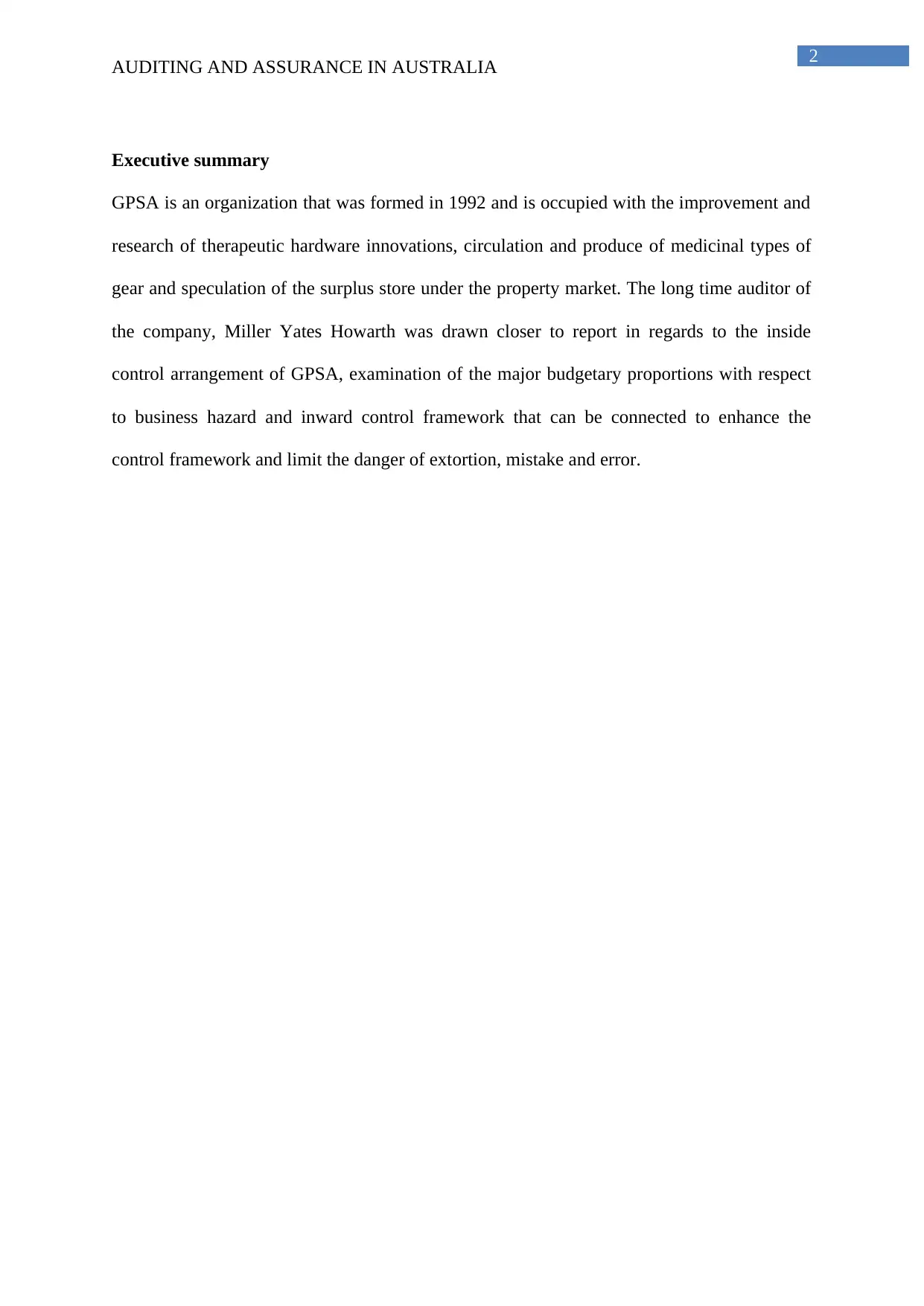
2
AUDITING AND ASSURANCE IN AUSTRALIA
Executive summary
GPSA is an organization that was formed in 1992 and is occupied with the improvement and
research of therapeutic hardware innovations, circulation and produce of medicinal types of
gear and speculation of the surplus store under the property market. The long time auditor of
the company, Miller Yates Howarth was drawn closer to report in regards to the inside
control arrangement of GPSA, examination of the major budgetary proportions with respect
to business hazard and inward control framework that can be connected to enhance the
control framework and limit the danger of extortion, mistake and error.
AUDITING AND ASSURANCE IN AUSTRALIA
Executive summary
GPSA is an organization that was formed in 1992 and is occupied with the improvement and
research of therapeutic hardware innovations, circulation and produce of medicinal types of
gear and speculation of the surplus store under the property market. The long time auditor of
the company, Miller Yates Howarth was drawn closer to report in regards to the inside
control arrangement of GPSA, examination of the major budgetary proportions with respect
to business hazard and inward control framework that can be connected to enhance the
control framework and limit the danger of extortion, mistake and error.
⊘ This is a preview!⊘
Do you want full access?
Subscribe today to unlock all pages.

Trusted by 1+ million students worldwide
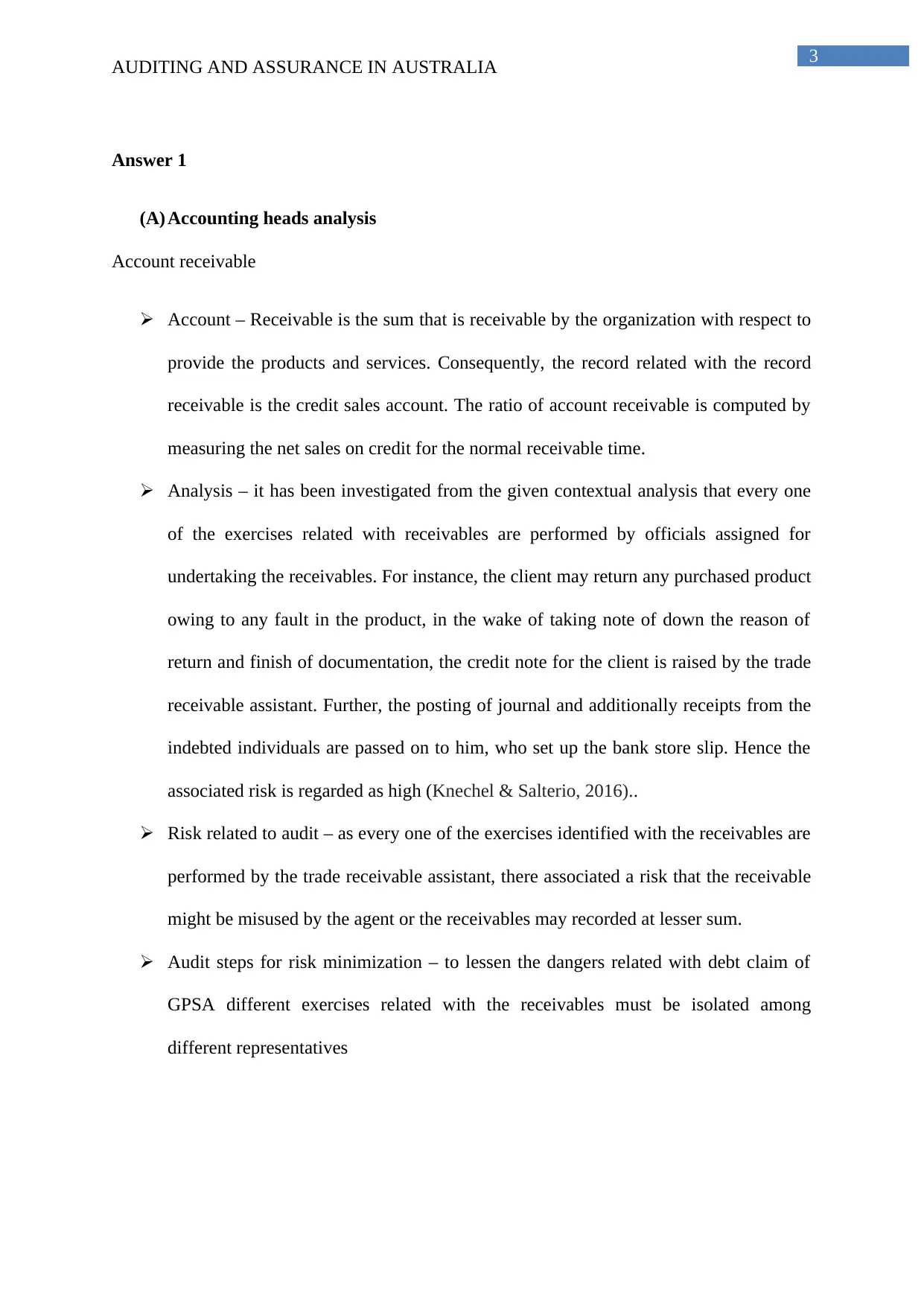
3
AUDITING AND ASSURANCE IN AUSTRALIA
Answer 1
(A) Accounting heads analysis
Account receivable
Account – Receivable is the sum that is receivable by the organization with respect to
provide the products and services. Consequently, the record related with the record
receivable is the credit sales account. The ratio of account receivable is computed by
measuring the net sales on credit for the normal receivable time.
Analysis – it has been investigated from the given contextual analysis that every one
of the exercises related with receivables are performed by officials assigned for
undertaking the receivables. For instance, the client may return any purchased product
owing to any fault in the product, in the wake of taking note of down the reason of
return and finish of documentation, the credit note for the client is raised by the trade
receivable assistant. Further, the posting of journal and additionally receipts from the
indebted individuals are passed on to him, who set up the bank store slip. Hence the
associated risk is regarded as high (Knechel & Salterio, 2016)..
Risk related to audit – as every one of the exercises identified with the receivables are
performed by the trade receivable assistant, there associated a risk that the receivable
might be misused by the agent or the receivables may recorded at lesser sum.
Audit steps for risk minimization – to lessen the dangers related with debt claim of
GPSA different exercises related with the receivables must be isolated among
different representatives
AUDITING AND ASSURANCE IN AUSTRALIA
Answer 1
(A) Accounting heads analysis
Account receivable
Account – Receivable is the sum that is receivable by the organization with respect to
provide the products and services. Consequently, the record related with the record
receivable is the credit sales account. The ratio of account receivable is computed by
measuring the net sales on credit for the normal receivable time.
Analysis – it has been investigated from the given contextual analysis that every one
of the exercises related with receivables are performed by officials assigned for
undertaking the receivables. For instance, the client may return any purchased product
owing to any fault in the product, in the wake of taking note of down the reason of
return and finish of documentation, the credit note for the client is raised by the trade
receivable assistant. Further, the posting of journal and additionally receipts from the
indebted individuals are passed on to him, who set up the bank store slip. Hence the
associated risk is regarded as high (Knechel & Salterio, 2016)..
Risk related to audit – as every one of the exercises identified with the receivables are
performed by the trade receivable assistant, there associated a risk that the receivable
might be misused by the agent or the receivables may recorded at lesser sum.
Audit steps for risk minimization – to lessen the dangers related with debt claim of
GPSA different exercises related with the receivables must be isolated among
different representatives
Paraphrase This Document
Need a fresh take? Get an instant paraphrase of this document with our AI Paraphraser
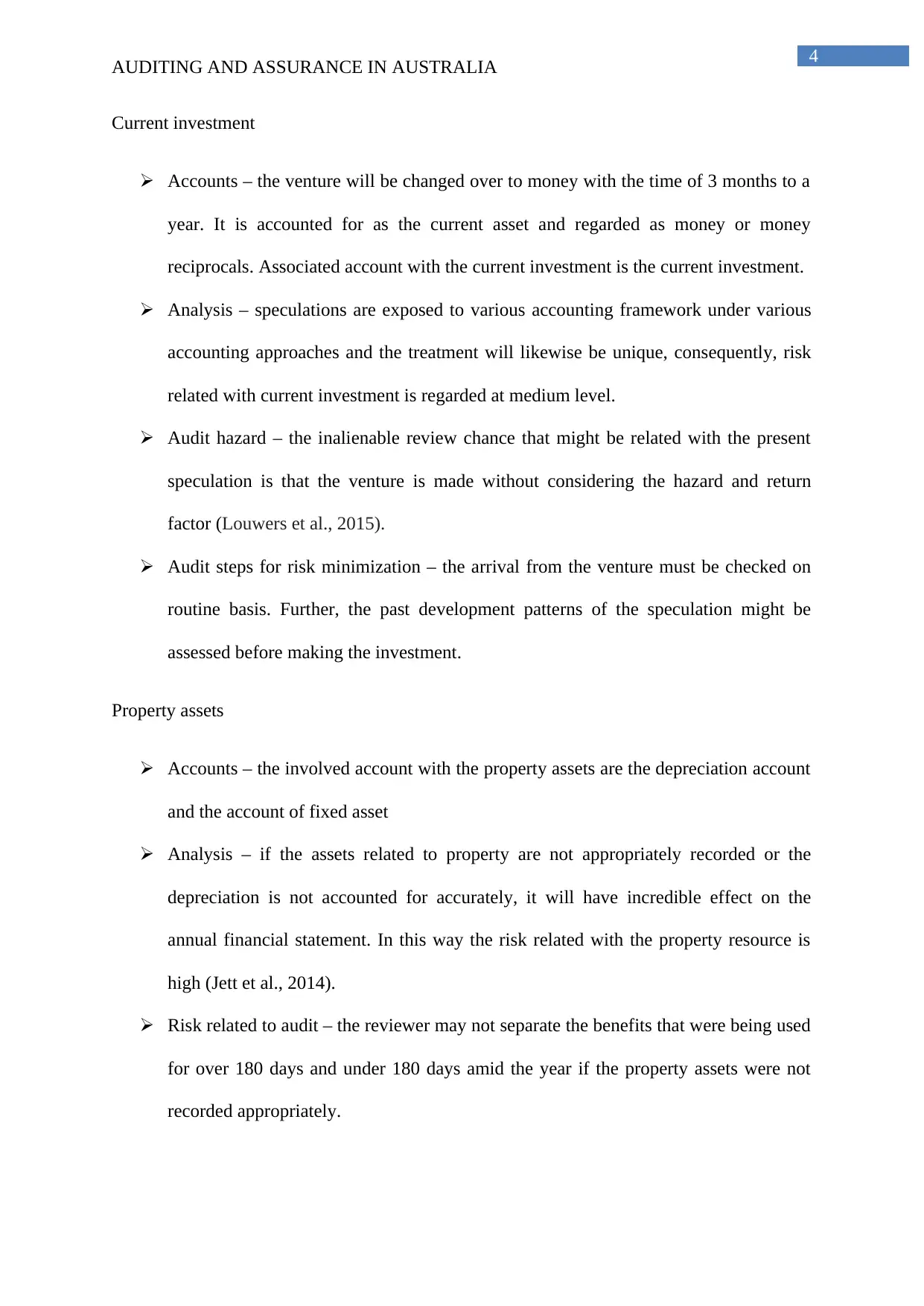
4
AUDITING AND ASSURANCE IN AUSTRALIA
Current investment
Accounts – the venture will be changed over to money with the time of 3 months to a
year. It is accounted for as the current asset and regarded as money or money
reciprocals. Associated account with the current investment is the current investment.
Analysis – speculations are exposed to various accounting framework under various
accounting approaches and the treatment will likewise be unique, consequently, risk
related with current investment is regarded at medium level.
Audit hazard – the inalienable review chance that might be related with the present
speculation is that the venture is made without considering the hazard and return
factor (Louwers et al., 2015).
Audit steps for risk minimization – the arrival from the venture must be checked on
routine basis. Further, the past development patterns of the speculation might be
assessed before making the investment.
Property assets
Accounts – the involved account with the property assets are the depreciation account
and the account of fixed asset
Analysis – if the assets related to property are not appropriately recorded or the
depreciation is not accounted for accurately, it will have incredible effect on the
annual financial statement. In this way the risk related with the property resource is
high (Jett et al., 2014).
Risk related to audit – the reviewer may not separate the benefits that were being used
for over 180 days and under 180 days amid the year if the property assets were not
recorded appropriately.
AUDITING AND ASSURANCE IN AUSTRALIA
Current investment
Accounts – the venture will be changed over to money with the time of 3 months to a
year. It is accounted for as the current asset and regarded as money or money
reciprocals. Associated account with the current investment is the current investment.
Analysis – speculations are exposed to various accounting framework under various
accounting approaches and the treatment will likewise be unique, consequently, risk
related with current investment is regarded at medium level.
Audit hazard – the inalienable review chance that might be related with the present
speculation is that the venture is made without considering the hazard and return
factor (Louwers et al., 2015).
Audit steps for risk minimization – the arrival from the venture must be checked on
routine basis. Further, the past development patterns of the speculation might be
assessed before making the investment.
Property assets
Accounts – the involved account with the property assets are the depreciation account
and the account of fixed asset
Analysis – if the assets related to property are not appropriately recorded or the
depreciation is not accounted for accurately, it will have incredible effect on the
annual financial statement. In this way the risk related with the property resource is
high (Jett et al., 2014).
Risk related to audit – the reviewer may not separate the benefits that were being used
for over 180 days and under 180 days amid the year if the property assets were not
recorded appropriately.
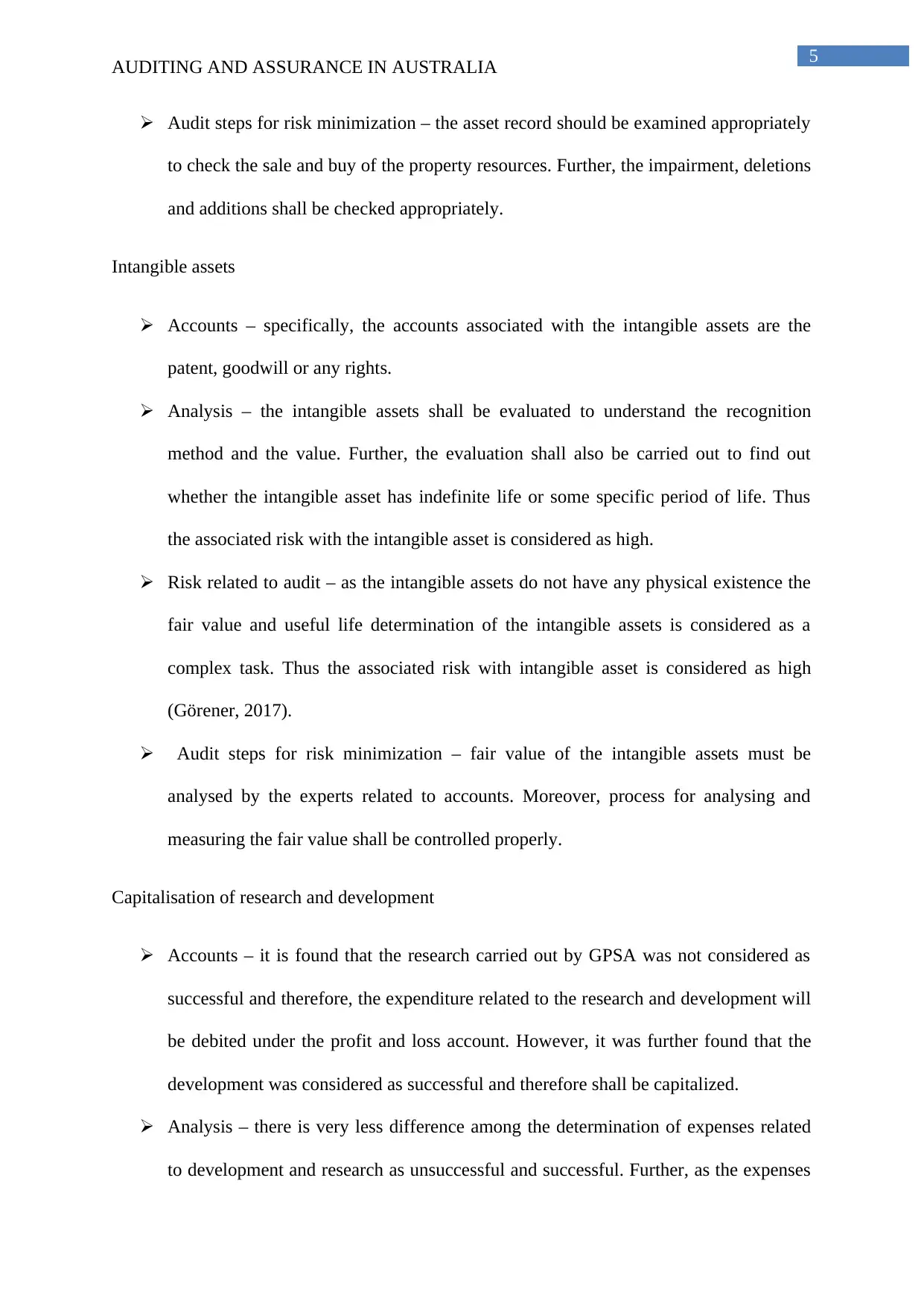
5
AUDITING AND ASSURANCE IN AUSTRALIA
Audit steps for risk minimization – the asset record should be examined appropriately
to check the sale and buy of the property resources. Further, the impairment, deletions
and additions shall be checked appropriately.
Intangible assets
Accounts – specifically, the accounts associated with the intangible assets are the
patent, goodwill or any rights.
Analysis – the intangible assets shall be evaluated to understand the recognition
method and the value. Further, the evaluation shall also be carried out to find out
whether the intangible asset has indefinite life or some specific period of life. Thus
the associated risk with the intangible asset is considered as high.
Risk related to audit – as the intangible assets do not have any physical existence the
fair value and useful life determination of the intangible assets is considered as a
complex task. Thus the associated risk with intangible asset is considered as high
(Görener, 2017).
Audit steps for risk minimization – fair value of the intangible assets must be
analysed by the experts related to accounts. Moreover, process for analysing and
measuring the fair value shall be controlled properly.
Capitalisation of research and development
Accounts – it is found that the research carried out by GPSA was not considered as
successful and therefore, the expenditure related to the research and development will
be debited under the profit and loss account. However, it was further found that the
development was considered as successful and therefore shall be capitalized.
Analysis – there is very less difference among the determination of expenses related
to development and research as unsuccessful and successful. Further, as the expenses
AUDITING AND ASSURANCE IN AUSTRALIA
Audit steps for risk minimization – the asset record should be examined appropriately
to check the sale and buy of the property resources. Further, the impairment, deletions
and additions shall be checked appropriately.
Intangible assets
Accounts – specifically, the accounts associated with the intangible assets are the
patent, goodwill or any rights.
Analysis – the intangible assets shall be evaluated to understand the recognition
method and the value. Further, the evaluation shall also be carried out to find out
whether the intangible asset has indefinite life or some specific period of life. Thus
the associated risk with the intangible asset is considered as high.
Risk related to audit – as the intangible assets do not have any physical existence the
fair value and useful life determination of the intangible assets is considered as a
complex task. Thus the associated risk with intangible asset is considered as high
(Görener, 2017).
Audit steps for risk minimization – fair value of the intangible assets must be
analysed by the experts related to accounts. Moreover, process for analysing and
measuring the fair value shall be controlled properly.
Capitalisation of research and development
Accounts – it is found that the research carried out by GPSA was not considered as
successful and therefore, the expenditure related to the research and development will
be debited under the profit and loss account. However, it was further found that the
development was considered as successful and therefore shall be capitalized.
Analysis – there is very less difference among the determination of expenses related
to development and research as unsuccessful and successful. Further, as the expenses
⊘ This is a preview!⊘
Do you want full access?
Subscribe today to unlock all pages.

Trusted by 1+ million students worldwide
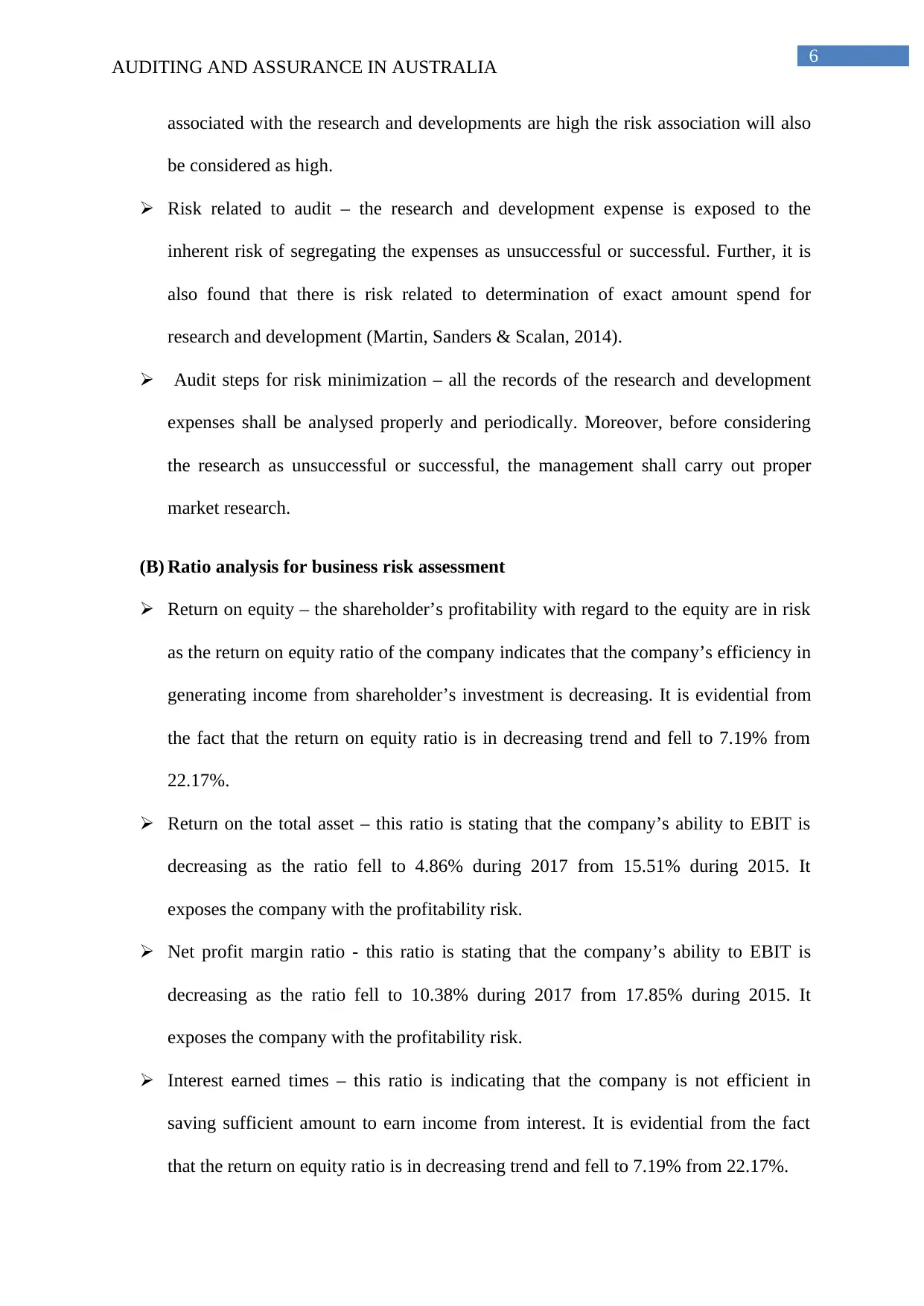
6
AUDITING AND ASSURANCE IN AUSTRALIA
associated with the research and developments are high the risk association will also
be considered as high.
Risk related to audit – the research and development expense is exposed to the
inherent risk of segregating the expenses as unsuccessful or successful. Further, it is
also found that there is risk related to determination of exact amount spend for
research and development (Martin, Sanders & Scalan, 2014).
Audit steps for risk minimization – all the records of the research and development
expenses shall be analysed properly and periodically. Moreover, before considering
the research as unsuccessful or successful, the management shall carry out proper
market research.
(B) Ratio analysis for business risk assessment
Return on equity – the shareholder’s profitability with regard to the equity are in risk
as the return on equity ratio of the company indicates that the company’s efficiency in
generating income from shareholder’s investment is decreasing. It is evidential from
the fact that the return on equity ratio is in decreasing trend and fell to 7.19% from
22.17%.
Return on the total asset – this ratio is stating that the company’s ability to EBIT is
decreasing as the ratio fell to 4.86% during 2017 from 15.51% during 2015. It
exposes the company with the profitability risk.
Net profit margin ratio - this ratio is stating that the company’s ability to EBIT is
decreasing as the ratio fell to 10.38% during 2017 from 17.85% during 2015. It
exposes the company with the profitability risk.
Interest earned times – this ratio is indicating that the company is not efficient in
saving sufficient amount to earn income from interest. It is evidential from the fact
that the return on equity ratio is in decreasing trend and fell to 7.19% from 22.17%.
AUDITING AND ASSURANCE IN AUSTRALIA
associated with the research and developments are high the risk association will also
be considered as high.
Risk related to audit – the research and development expense is exposed to the
inherent risk of segregating the expenses as unsuccessful or successful. Further, it is
also found that there is risk related to determination of exact amount spend for
research and development (Martin, Sanders & Scalan, 2014).
Audit steps for risk minimization – all the records of the research and development
expenses shall be analysed properly and periodically. Moreover, before considering
the research as unsuccessful or successful, the management shall carry out proper
market research.
(B) Ratio analysis for business risk assessment
Return on equity – the shareholder’s profitability with regard to the equity are in risk
as the return on equity ratio of the company indicates that the company’s efficiency in
generating income from shareholder’s investment is decreasing. It is evidential from
the fact that the return on equity ratio is in decreasing trend and fell to 7.19% from
22.17%.
Return on the total asset – this ratio is stating that the company’s ability to EBIT is
decreasing as the ratio fell to 4.86% during 2017 from 15.51% during 2015. It
exposes the company with the profitability risk.
Net profit margin ratio - this ratio is stating that the company’s ability to EBIT is
decreasing as the ratio fell to 10.38% during 2017 from 17.85% during 2015. It
exposes the company with the profitability risk.
Interest earned times – this ratio is indicating that the company is not efficient in
saving sufficient amount to earn income from interest. It is evidential from the fact
that the return on equity ratio is in decreasing trend and fell to 7.19% from 22.17%.
Paraphrase This Document
Need a fresh take? Get an instant paraphrase of this document with our AI Paraphraser
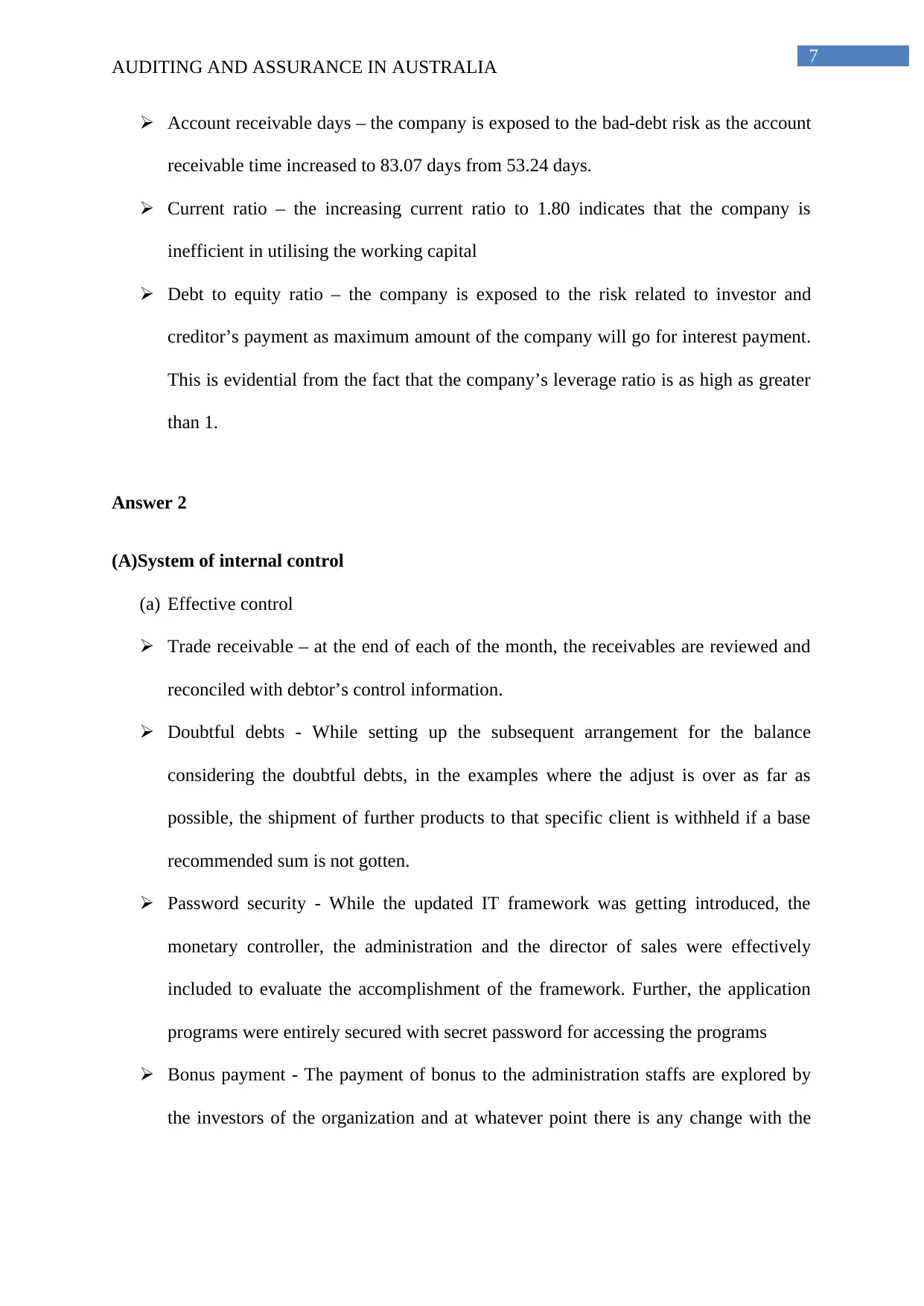
7
AUDITING AND ASSURANCE IN AUSTRALIA
Account receivable days – the company is exposed to the bad-debt risk as the account
receivable time increased to 83.07 days from 53.24 days.
Current ratio – the increasing current ratio to 1.80 indicates that the company is
inefficient in utilising the working capital
Debt to equity ratio – the company is exposed to the risk related to investor and
creditor’s payment as maximum amount of the company will go for interest payment.
This is evidential from the fact that the company’s leverage ratio is as high as greater
than 1.
Answer 2
(A)System of internal control
(a) Effective control
Trade receivable – at the end of each of the month, the receivables are reviewed and
reconciled with debtor’s control information.
Doubtful debts - While setting up the subsequent arrangement for the balance
considering the doubtful debts, in the examples where the adjust is over as far as
possible, the shipment of further products to that specific client is withheld if a base
recommended sum is not gotten.
Password security - While the updated IT framework was getting introduced, the
monetary controller, the administration and the director of sales were effectively
included to evaluate the accomplishment of the framework. Further, the application
programs were entirely secured with secret password for accessing the programs
Bonus payment - The payment of bonus to the administration staffs are explored by
the investors of the organization and at whatever point there is any change with the
AUDITING AND ASSURANCE IN AUSTRALIA
Account receivable days – the company is exposed to the bad-debt risk as the account
receivable time increased to 83.07 days from 53.24 days.
Current ratio – the increasing current ratio to 1.80 indicates that the company is
inefficient in utilising the working capital
Debt to equity ratio – the company is exposed to the risk related to investor and
creditor’s payment as maximum amount of the company will go for interest payment.
This is evidential from the fact that the company’s leverage ratio is as high as greater
than 1.
Answer 2
(A)System of internal control
(a) Effective control
Trade receivable – at the end of each of the month, the receivables are reviewed and
reconciled with debtor’s control information.
Doubtful debts - While setting up the subsequent arrangement for the balance
considering the doubtful debts, in the examples where the adjust is over as far as
possible, the shipment of further products to that specific client is withheld if a base
recommended sum is not gotten.
Password security - While the updated IT framework was getting introduced, the
monetary controller, the administration and the director of sales were effectively
included to evaluate the accomplishment of the framework. Further, the application
programs were entirely secured with secret password for accessing the programs
Bonus payment - The payment of bonus to the administration staffs are explored by
the investors of the organization and at whatever point there is any change with the
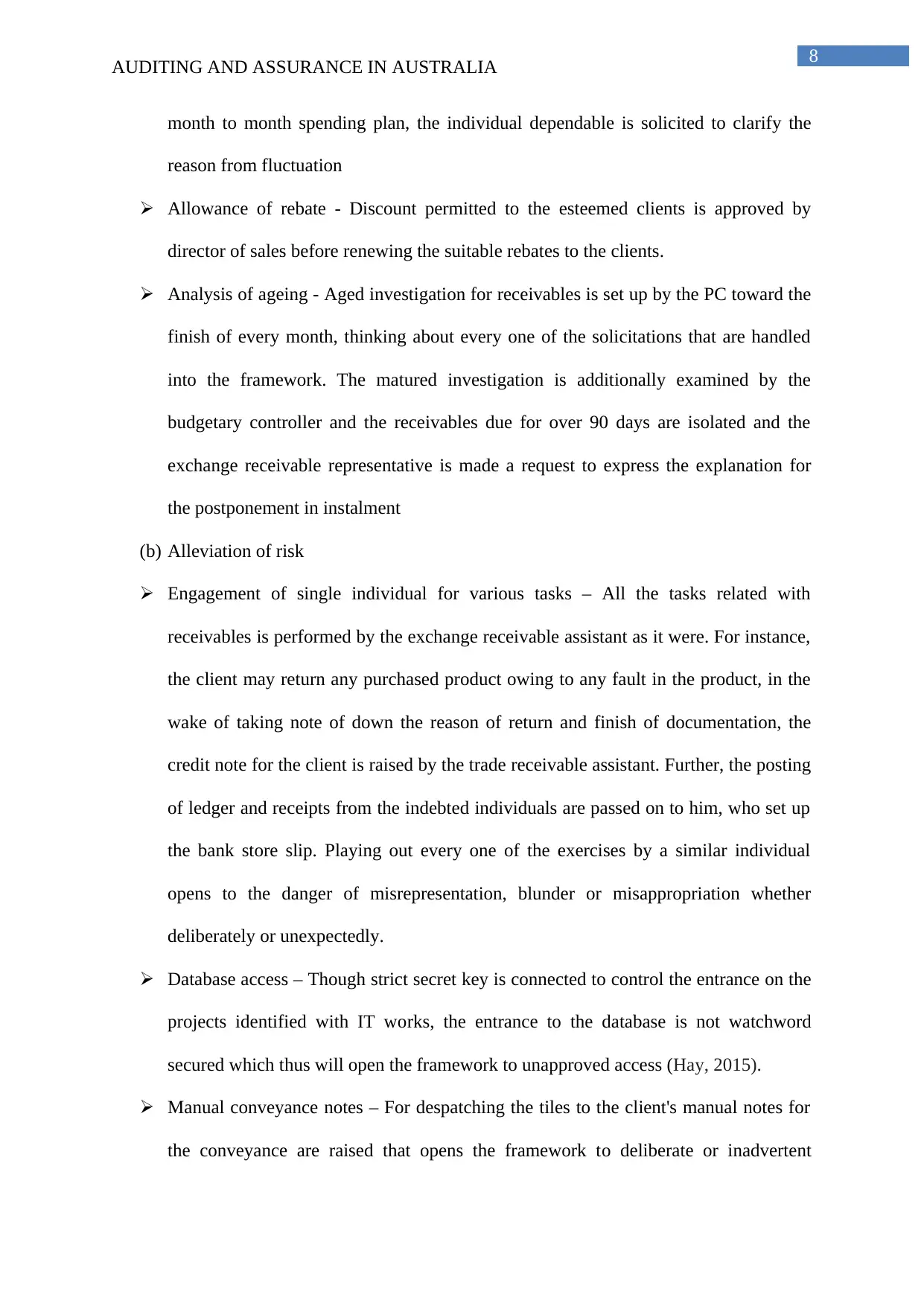
8
AUDITING AND ASSURANCE IN AUSTRALIA
month to month spending plan, the individual dependable is solicited to clarify the
reason from fluctuation
Allowance of rebate - Discount permitted to the esteemed clients is approved by
director of sales before renewing the suitable rebates to the clients.
Analysis of ageing - Aged investigation for receivables is set up by the PC toward the
finish of every month, thinking about every one of the solicitations that are handled
into the framework. The matured investigation is additionally examined by the
budgetary controller and the receivables due for over 90 days are isolated and the
exchange receivable representative is made a request to express the explanation for
the postponement in instalment
(b) Alleviation of risk
Engagement of single individual for various tasks – All the tasks related with
receivables is performed by the exchange receivable assistant as it were. For instance,
the client may return any purchased product owing to any fault in the product, in the
wake of taking note of down the reason of return and finish of documentation, the
credit note for the client is raised by the trade receivable assistant. Further, the posting
of ledger and receipts from the indebted individuals are passed on to him, who set up
the bank store slip. Playing out every one of the exercises by a similar individual
opens to the danger of misrepresentation, blunder or misappropriation whether
deliberately or unexpectedly.
Database access – Though strict secret key is connected to control the entrance on the
projects identified with IT works, the entrance to the database is not watchword
secured which thus will open the framework to unapproved access (Hay, 2015).
Manual conveyance notes – For despatching the tiles to the client's manual notes for
the conveyance are raised that opens the framework to deliberate or inadvertent
AUDITING AND ASSURANCE IN AUSTRALIA
month to month spending plan, the individual dependable is solicited to clarify the
reason from fluctuation
Allowance of rebate - Discount permitted to the esteemed clients is approved by
director of sales before renewing the suitable rebates to the clients.
Analysis of ageing - Aged investigation for receivables is set up by the PC toward the
finish of every month, thinking about every one of the solicitations that are handled
into the framework. The matured investigation is additionally examined by the
budgetary controller and the receivables due for over 90 days are isolated and the
exchange receivable representative is made a request to express the explanation for
the postponement in instalment
(b) Alleviation of risk
Engagement of single individual for various tasks – All the tasks related with
receivables is performed by the exchange receivable assistant as it were. For instance,
the client may return any purchased product owing to any fault in the product, in the
wake of taking note of down the reason of return and finish of documentation, the
credit note for the client is raised by the trade receivable assistant. Further, the posting
of ledger and receipts from the indebted individuals are passed on to him, who set up
the bank store slip. Playing out every one of the exercises by a similar individual
opens to the danger of misrepresentation, blunder or misappropriation whether
deliberately or unexpectedly.
Database access – Though strict secret key is connected to control the entrance on the
projects identified with IT works, the entrance to the database is not watchword
secured which thus will open the framework to unapproved access (Hay, 2015).
Manual conveyance notes – For despatching the tiles to the client's manual notes for
the conveyance are raised that opens the framework to deliberate or inadvertent
⊘ This is a preview!⊘
Do you want full access?
Subscribe today to unlock all pages.

Trusted by 1+ million students worldwide
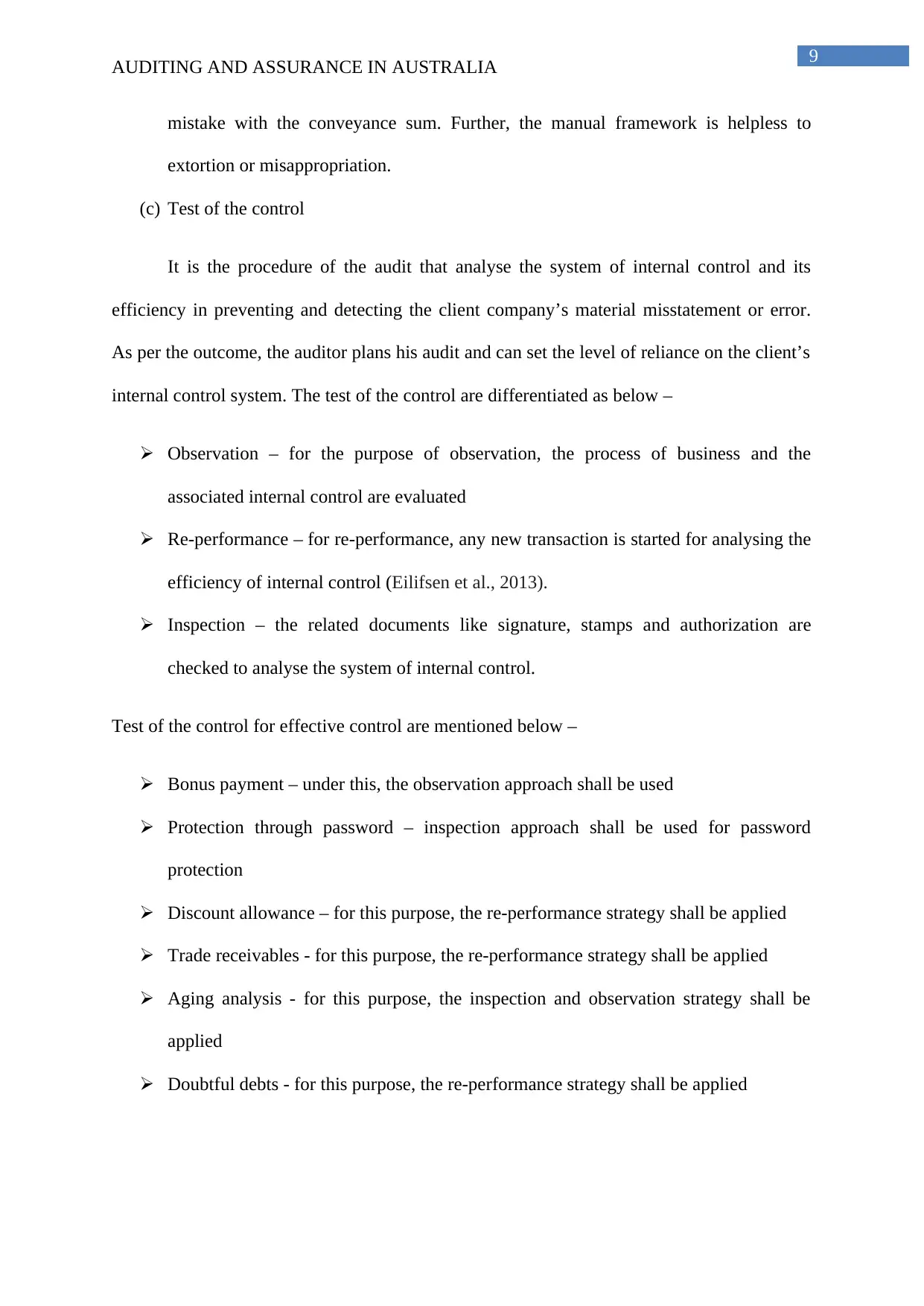
9
AUDITING AND ASSURANCE IN AUSTRALIA
mistake with the conveyance sum. Further, the manual framework is helpless to
extortion or misappropriation.
(c) Test of the control
It is the procedure of the audit that analyse the system of internal control and its
efficiency in preventing and detecting the client company’s material misstatement or error.
As per the outcome, the auditor plans his audit and can set the level of reliance on the client’s
internal control system. The test of the control are differentiated as below –
Observation – for the purpose of observation, the process of business and the
associated internal control are evaluated
Re-performance – for re-performance, any new transaction is started for analysing the
efficiency of internal control (Eilifsen et al., 2013).
Inspection – the related documents like signature, stamps and authorization are
checked to analyse the system of internal control.
Test of the control for effective control are mentioned below –
Bonus payment – under this, the observation approach shall be used
Protection through password – inspection approach shall be used for password
protection
Discount allowance – for this purpose, the re-performance strategy shall be applied
Trade receivables - for this purpose, the re-performance strategy shall be applied
Aging analysis - for this purpose, the inspection and observation strategy shall be
applied
Doubtful debts - for this purpose, the re-performance strategy shall be applied
AUDITING AND ASSURANCE IN AUSTRALIA
mistake with the conveyance sum. Further, the manual framework is helpless to
extortion or misappropriation.
(c) Test of the control
It is the procedure of the audit that analyse the system of internal control and its
efficiency in preventing and detecting the client company’s material misstatement or error.
As per the outcome, the auditor plans his audit and can set the level of reliance on the client’s
internal control system. The test of the control are differentiated as below –
Observation – for the purpose of observation, the process of business and the
associated internal control are evaluated
Re-performance – for re-performance, any new transaction is started for analysing the
efficiency of internal control (Eilifsen et al., 2013).
Inspection – the related documents like signature, stamps and authorization are
checked to analyse the system of internal control.
Test of the control for effective control are mentioned below –
Bonus payment – under this, the observation approach shall be used
Protection through password – inspection approach shall be used for password
protection
Discount allowance – for this purpose, the re-performance strategy shall be applied
Trade receivables - for this purpose, the re-performance strategy shall be applied
Aging analysis - for this purpose, the inspection and observation strategy shall be
applied
Doubtful debts - for this purpose, the re-performance strategy shall be applied
Paraphrase This Document
Need a fresh take? Get an instant paraphrase of this document with our AI Paraphraser
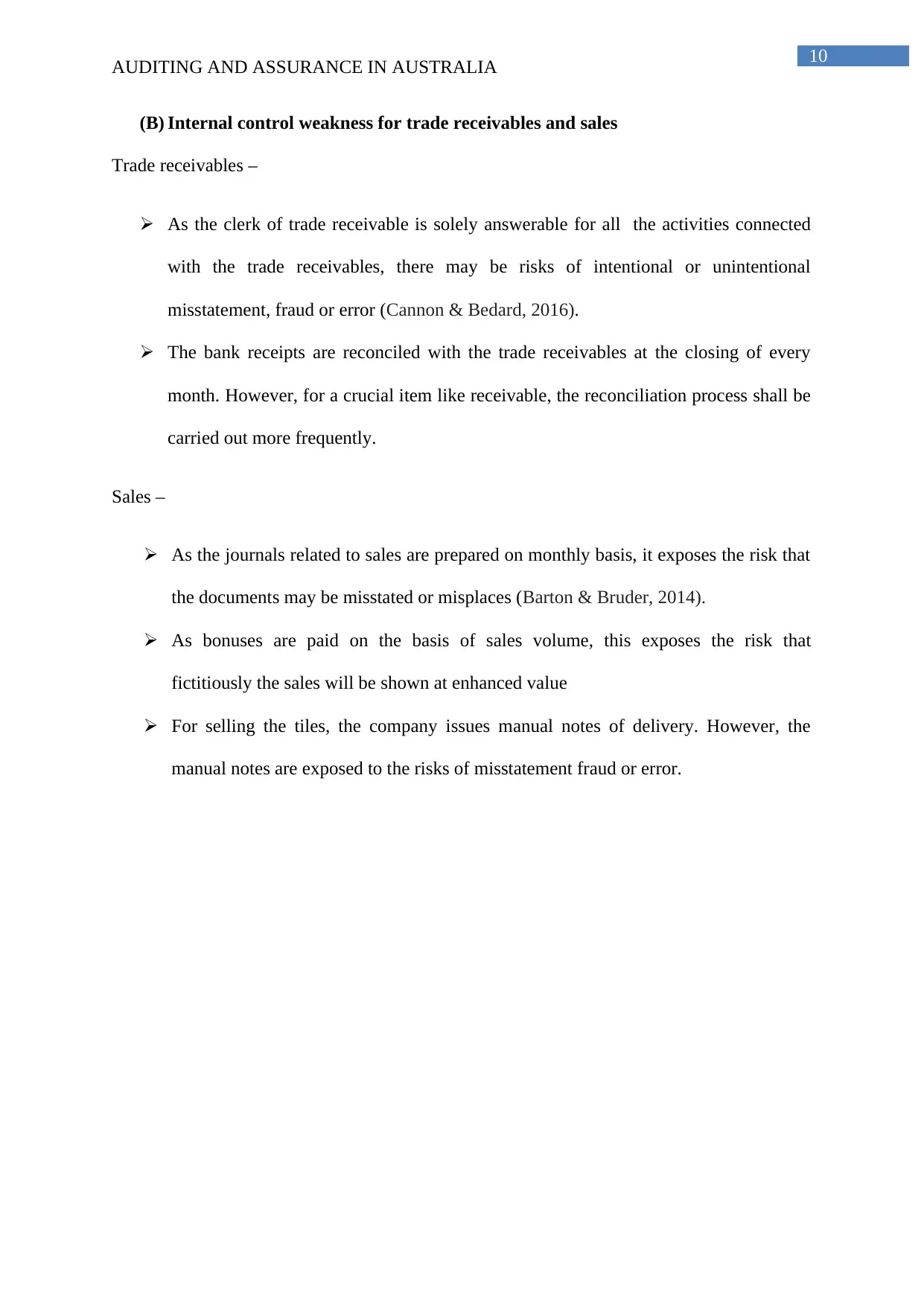
10
AUDITING AND ASSURANCE IN AUSTRALIA
(B) Internal control weakness for trade receivables and sales
Trade receivables –
As the clerk of trade receivable is solely answerable for all the activities connected
with the trade receivables, there may be risks of intentional or unintentional
misstatement, fraud or error (Cannon & Bedard, 2016).
The bank receipts are reconciled with the trade receivables at the closing of every
month. However, for a crucial item like receivable, the reconciliation process shall be
carried out more frequently.
Sales –
As the journals related to sales are prepared on monthly basis, it exposes the risk that
the documents may be misstated or misplaces (Barton & Bruder, 2014).
As bonuses are paid on the basis of sales volume, this exposes the risk that
fictitiously the sales will be shown at enhanced value
For selling the tiles, the company issues manual notes of delivery. However, the
manual notes are exposed to the risks of misstatement fraud or error.
AUDITING AND ASSURANCE IN AUSTRALIA
(B) Internal control weakness for trade receivables and sales
Trade receivables –
As the clerk of trade receivable is solely answerable for all the activities connected
with the trade receivables, there may be risks of intentional or unintentional
misstatement, fraud or error (Cannon & Bedard, 2016).
The bank receipts are reconciled with the trade receivables at the closing of every
month. However, for a crucial item like receivable, the reconciliation process shall be
carried out more frequently.
Sales –
As the journals related to sales are prepared on monthly basis, it exposes the risk that
the documents may be misstated or misplaces (Barton & Bruder, 2014).
As bonuses are paid on the basis of sales volume, this exposes the risk that
fictitiously the sales will be shown at enhanced value
For selling the tiles, the company issues manual notes of delivery. However, the
manual notes are exposed to the risks of misstatement fraud or error.
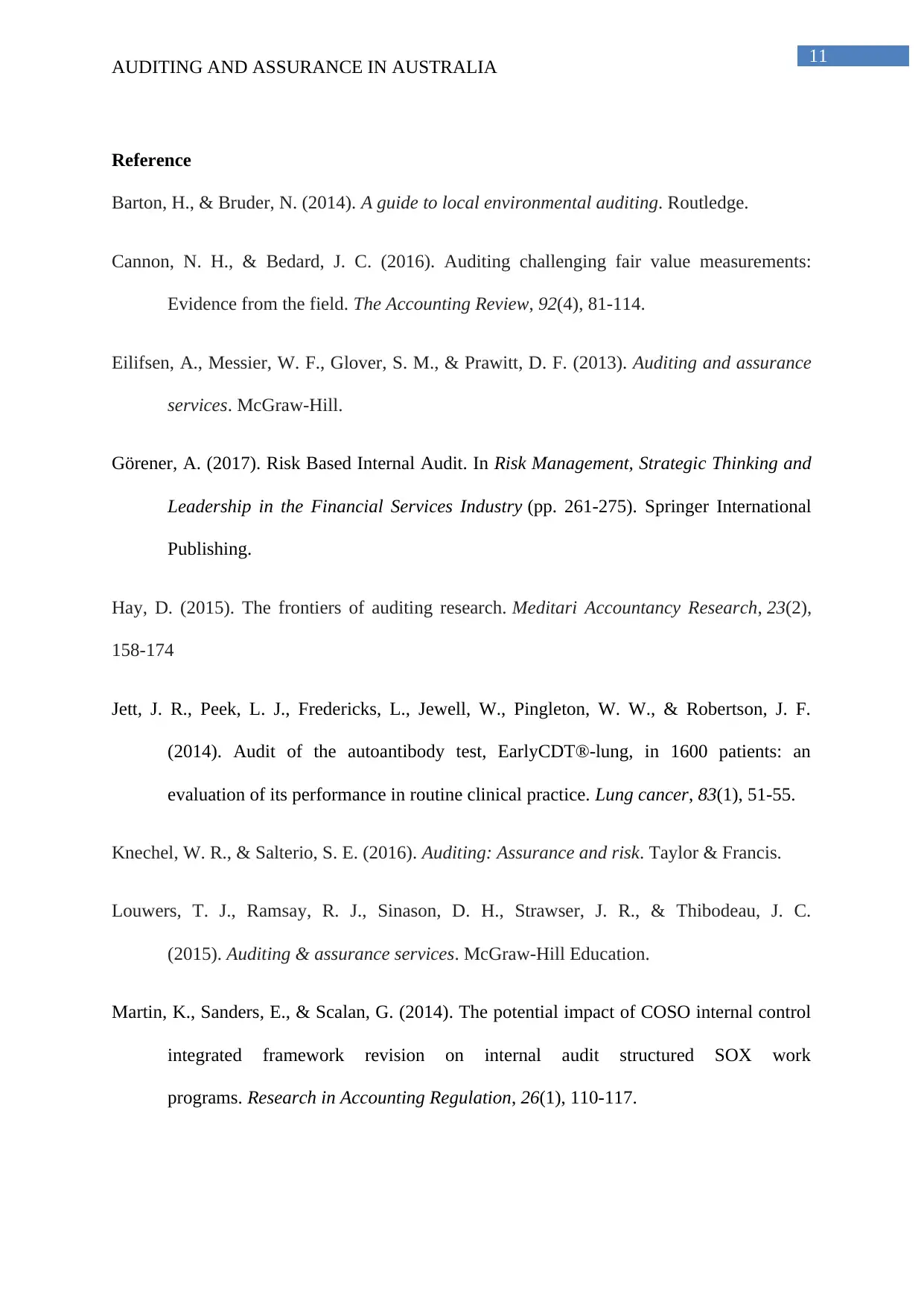
11
AUDITING AND ASSURANCE IN AUSTRALIA
Reference
Barton, H., & Bruder, N. (2014). A guide to local environmental auditing. Routledge.
Cannon, N. H., & Bedard, J. C. (2016). Auditing challenging fair value measurements:
Evidence from the field. The Accounting Review, 92(4), 81-114.
Eilifsen, A., Messier, W. F., Glover, S. M., & Prawitt, D. F. (2013). Auditing and assurance
services. McGraw-Hill.
Görener, A. (2017). Risk Based Internal Audit. In Risk Management, Strategic Thinking and
Leadership in the Financial Services Industry (pp. 261-275). Springer International
Publishing.
Hay, D. (2015). The frontiers of auditing research. Meditari Accountancy Research, 23(2),
158-174
Jett, J. R., Peek, L. J., Fredericks, L., Jewell, W., Pingleton, W. W., & Robertson, J. F.
(2014). Audit of the autoantibody test, EarlyCDT®-lung, in 1600 patients: an
evaluation of its performance in routine clinical practice. Lung cancer, 83(1), 51-55.
Knechel, W. R., & Salterio, S. E. (2016). Auditing: Assurance and risk. Taylor & Francis.
Louwers, T. J., Ramsay, R. J., Sinason, D. H., Strawser, J. R., & Thibodeau, J. C.
(2015). Auditing & assurance services. McGraw-Hill Education.
Martin, K., Sanders, E., & Scalan, G. (2014). The potential impact of COSO internal control
integrated framework revision on internal audit structured SOX work
programs. Research in Accounting Regulation, 26(1), 110-117.
AUDITING AND ASSURANCE IN AUSTRALIA
Reference
Barton, H., & Bruder, N. (2014). A guide to local environmental auditing. Routledge.
Cannon, N. H., & Bedard, J. C. (2016). Auditing challenging fair value measurements:
Evidence from the field. The Accounting Review, 92(4), 81-114.
Eilifsen, A., Messier, W. F., Glover, S. M., & Prawitt, D. F. (2013). Auditing and assurance
services. McGraw-Hill.
Görener, A. (2017). Risk Based Internal Audit. In Risk Management, Strategic Thinking and
Leadership in the Financial Services Industry (pp. 261-275). Springer International
Publishing.
Hay, D. (2015). The frontiers of auditing research. Meditari Accountancy Research, 23(2),
158-174
Jett, J. R., Peek, L. J., Fredericks, L., Jewell, W., Pingleton, W. W., & Robertson, J. F.
(2014). Audit of the autoantibody test, EarlyCDT®-lung, in 1600 patients: an
evaluation of its performance in routine clinical practice. Lung cancer, 83(1), 51-55.
Knechel, W. R., & Salterio, S. E. (2016). Auditing: Assurance and risk. Taylor & Francis.
Louwers, T. J., Ramsay, R. J., Sinason, D. H., Strawser, J. R., & Thibodeau, J. C.
(2015). Auditing & assurance services. McGraw-Hill Education.
Martin, K., Sanders, E., & Scalan, G. (2014). The potential impact of COSO internal control
integrated framework revision on internal audit structured SOX work
programs. Research in Accounting Regulation, 26(1), 110-117.
⊘ This is a preview!⊘
Do you want full access?
Subscribe today to unlock all pages.

Trusted by 1+ million students worldwide
1 out of 13
Related Documents
Your All-in-One AI-Powered Toolkit for Academic Success.
+13062052269
info@desklib.com
Available 24*7 on WhatsApp / Email
![[object Object]](/_next/static/media/star-bottom.7253800d.svg)
Unlock your academic potential
Copyright © 2020–2025 A2Z Services. All Rights Reserved. Developed and managed by ZUCOL.





